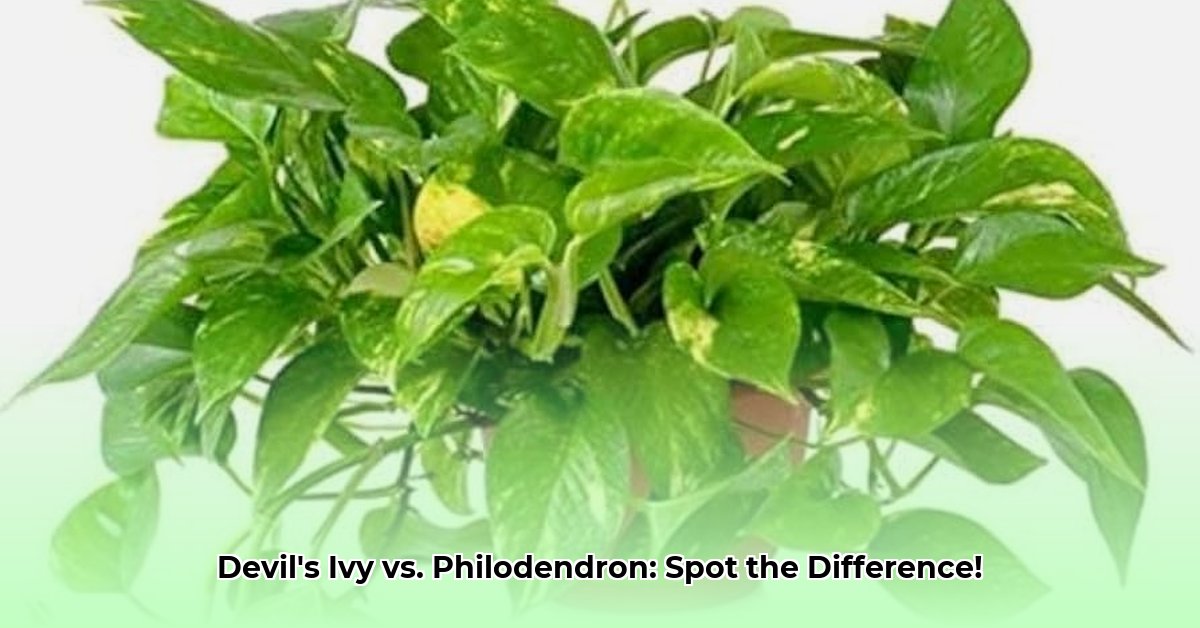# Pothos vs. Philodendron: An Identification Guide
Pothos and philodendrons are two of the most popular houseplants, often mistaken for each other due to their similar appearance. This comprehensive guide provides expert tips on how to distinguish these plants, enabling you to provide the best possible care.
## Decoding the Mystery: Telling Pothos and Philodendrons Apart
Many plant enthusiasts struggle to differentiate between pothos and philodendrons. Both exhibit heart-shaped leaves and a vining growth habit, leading to frequent confusion. However, by focusing on specific characteristics, you can confidently identify each plant.
### Leaf Characteristics: Texture, Shape, and Sheen
Examine the leaves closely, paying attention to their texture, shape, and sheen.
* **Texture:** Gently feel the leaf surface. Pothos leaves tend to be thicker and waxier compared to philodendron leaves. Philodendron leaves often have a smoother, sometimes velvety texture.
* **Shape:** While both plants have heart-shaped leaves, the base of the leaf where it connects to the stem differs. Pothos leaves have a relatively straight base, whereas philodendron leaves typically feature a more pronounced curve or indentation.
* **Sheen:** Pothos leaves often exhibit a glossy or waxy sheen, whereas philodendron leaves may have a more matte appearance.
### Stem Structure: Grooves vs. Smoothness
Inspect the stems of the plant. Pothos stems typically have grooves or ridges running along their length. Philodendron stems, in contrast, are generally smooth and rounded.
### Aerial Roots: Quantity and Form
Both pothos and philodendrons produce aerial roots, which they use to climb and attach to surfaces. However, there are differences in the quantity and form of these roots:
* **Quantity:** Pothos usually have one aerial root per node (the point where a leaf emerges from the stem). Philodendrons, on the other hand, often have multiple aerial roots per node.
* **Form:** Pothos aerial roots tend to be thicker and sturdier, while philodendron aerial roots are usually thinner and more numerous.
### Cataphylls: Protective Leaf Structures
Look for cataphylls, small leaf-like structures that protect emerging leaves. Philodendrons produce cataphylls, which eventually dry up and fall off, leaving a scar on the stem. Pothos do not have cataphylls.
### Growth Patterns: Climbing vs. Trailing
Observe the growth habits of the plant. Pothos are known for their trailing growth, cascading downwards from hanging baskets or shelves. Philodendrons can both climb and trail, depending on the variety.
### Quick Reference Table: Key Distinguishing Features
| Feature | Pothos | Philodendron |
| :---------------- | :------------------------------------------- | :--------------------------------------------- |
| Leaf Texture | Thick, waxy | Smooth, sometimes velvety |
| Leaf Base Shape | Relatively straight | Curved or indented |
| Stem Structure | Grooved or ridged | Smooth, rounded |
| Aerial Roots | One per node, thick | Multiple per node, thinner |
| Cataphylls | Absent | Present |
| Growth Habit | Trailing | Climbing or trailing |
### Considerations for Accurate Identification
Remember that variations exist within both pothos and philodendron species. Some cultivars may exhibit traits that blur the lines between the two plants. Consider all characteristics together rather than relying on a single feature for identification.
For further assistance, consult online resources with detailed images or seek advice from local gardening experts or nurseries.
**Key Points:**
* Leaf texture, stem structure, and aerial root characteristics are crucial for distinguishing pothos from philodendrons.
* The presence or absence of cataphylls is a definitive identification marker.
* Consider the overall growth habit and consult multiple features for accurate identification.
Understanding these distinctions empowers you to provide optimal care for your houseplants.
## Delving Deeper: Leaf Texture as a Defining Trait
**Key Takeaways:**
* Leaf texture is a primary factor in differentiating pothos and philodendrons.
* Combine leaf texture with other identifying features for accurate identification.
* Proper identification is essential for providing appropriate plant care.
* Cultivar variations may complicate identification, requiring careful observation.
### Understanding the Challenge
Distinguishing between pothos and philodendrons can be challenging due to their similar appearance. Both are vining plants in the Araceae family, often displaying heart-shaped leaves. Accurate identification relies on recognizing subtle differences, including leaf texture.
### Leaf Texture: A Hands-On Approach
Focus on the tactile sensation of the leaves. Pothos leaves often have a thicker, almost leathery texture with a waxy coating. Philodendron leaves, on the other hand, tend to be smoother, thinner, and sometimes slightly velvety.
### Beyond Texture: A Holistic Approach
Consider these additional features in conjunction with leaf texture:
* **Stems:** Pothos stems typically exhibit grooves or ridges, while philodendron stems are often smooth and rounded.
* **Aerial Roots:** Pothos usually develop aerial roots at the nodes of the stem, while philodendrons may produce aerial roots along the stem as well.
* **Cataphylls:** The presence of cataphylls, protective sheaths enclosing new leaves, indicates a philodendron. Pothos lack these structures.
* **Growth Habits:** Observe the plant's growth patterns. Pothos typically trail, while philodendrons may climb or trail depending on the species.
### Visual Aids: Enhancing Identification Skills
Utilize visual resources, such as online images, to compare different pothos and philodendron cultivars. Pay close attention to variations in leaf shape, texture, and other identifying characteristics.
### Comparison Chart: Summarizing Key Features
| Feature | Pothos | Philodendron |
| :---------------- | :------------------------------------------- | :--------------------------------------------- |
| **Leaf Texture** | Thicker, leathery, waxy | Smoother, thinner, sometimes velvety |
| Stem Structure | Grooved or ridged | Smooth, rounded |
| Aerial Roots | Nodes on the stem | Nodes and stem sides |
| Cataphylls | Absent | Present (protective sheaths around new leaves) |
## Advanced Insights: Leaf Texture and Petiole Structure
**Key Takeaways:**
* Leaf texture and petiole structure are crucial for distinguishing pothos and philodendrons.
* Pothos leaves are typically thicker and waxier, while philodendrons have thinner, matte leaves.
* Pothos petioles (leaf stalks) are grooved, while philodendron petioles are smooth and rounded.
* Cultivar variations can complicate identification, requiring careful observation.
Latest posts by Mark Soldy (see all)
- Glass Backsplash: Ideas For a Stylish Kitchen Update - December 2, 2025
- Glass On Tile: A Stylish Kitchen Backsplash Option - December 1, 2025
- Glass Tiles for Kitchen: Style and Durability Tips - November 30, 2025










